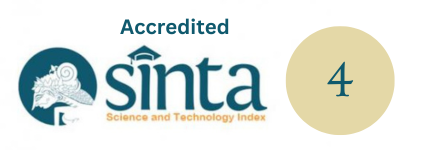Musical Composition Jurung-Jurung | Komposisi Musik Jurung-Jurung
DOI:
https://doi.org/10.59997/jurnalsenikarawitan.v4i2.3438Keywords:
Jurung-Jurung, Teknik, Jegog Jembrana, BaliAbstract
This article refers to the lack of literacy regarding the Jegog Jembrana gamelan in terms of musicality. The Jegog Jembrana gamelan has many techniques, one of which is the jurung-jurung technique. The jurung-jurung or transition technique is one of the stylists' interests in creating a new work. Jurung-jurung is one of the Jegog techniques, which means types of transitions in classical Jegog compositions and not all classical Jegog percussion transitions have the Jurung-jurung technique, but they are in accordance with the classical composition of Jegog percussion. The method I use is based on the creation method according to Alma. M Watkins namely exploration, improvisation, and formation. This method is very influential in making this composition because the stages are simple and easy to understand. The relevance of this work will be very useful for the community and artists who want to develop Jegog Jembrana art.
Downloads
References
Absil, F. (2015). A Guide to Schillinger’s Theory of Rhythm (2nd ed.).
Adi Surya, I. G., Saptono, S., & Partha, I. K. (2022). The Process of Music Creation Kelabu | Proses Kreasi Musik “Kelabu.” GHURNITA: Jurnal Seni Karawitan, 2(1), 62–70. https://doi.org/10.59997/jurnalsenikarawitan.v2i1.419
Adiputra, K. A. P., & Haryanto, T. (2022). Music Composition Makules | Komposisi Musik Makules. Ghurnita Jurnal Seni Karawitan, 2(2), 86–96. https://jurnal2.isi-dps.ac.id/index.php/ghurnita/article/view/406/460
Berndt, A., & Hähnel, T. (2010). Modelling musical dynamics. Proceedings of the 5th Audio Mostly Conference: A Conference on Interaction with Sound, 1–8. https://doi.org/10.1145/1859799.1859817
Cahyo, S. D. (2018). Notasi Musik Abad 20 dan 21 (1st ed.). Art Music Today.
Djelantik, A. A. M. (1999). Estetika Sebuah Pengantar (1st ed.). Masyarakat Seni Pertunjukan Indonesia.
Gusmanto, R. (2020). Modul Melodi & Rhythm. https://karawitan.isbiaceh.ac.id/wp-content/uploads/2020/09/Modul-Melodi-Rhythm.pdf
Link, M. W. C. (2018). Contemporary Music and Its Challenges for Music Theory. Harmonia: Journal of Arts Research and Education, 18(1), 39–44. https://doi.org/10.15294/harmonia.v18i1.13686
Marianto, B. (2022). Kamus Lengkap Bahasa Indonesia (1st ed.). Permata Press.
Maršík, L. (2017). Music Harmony Analysis: Towards a Harmonic Complexity of Musical Pieces [Rigorózní práce, Univerzita Karlova, Matematicko-fyzikální fakulta]. http://hdl.handle.net/20.500.11956/92896
McAuley, J. D. (2010). Tempo and Rhythm (pp. 165–199). https://doi.org/10.1007/978-1-4419-6114-3_6
Miller, H. M. (2017). Apresiasi Musik (Sunarto, Ed.; 1st ed.). Panta Rhei Books.
Nettl, B. (1983). The Study of Ethnomusicology Twenty-nine Issues and Concepts (1st ed.). University of Illinois Press.
Rai S, I. W. (2001). Gong Antologi Pemikiran (E. B. De Rosari, Ed.; 1st ed.). Bali Mangsi.
Rembang, I. N. (1984). Sekelumit Cara-Cara Pembuatan Gamelan Bali. Departemen Pendidikan dan Kebudayaan, Direktorat Jendral Kebudayaan, Proyek Pengembangan Kesenian Bali.
Santosa, H., Saptono, & Sutirtha, I. W. (2022). I Nyoman Windha Sang Maestro Karawitan Bali (Abdul (ed.)). Penerbit Adab. http://repo.isi-dps.ac.id/5100/
Saptono, Santosa, H., & Sutritha, I. W. (2024). Struktur Musik Iringan Tari Puspanjali. Panggung: Jurnal Seni Budaya, 34(1), 58–69. https://jurnal.isbi.ac.id/index.php/panggung/article/view/2446
Satya, I. P. G. W. (2023). Introduction to the Contemporary Musical Composition “Life Style” | Pengantar Komposisi Musik Kontemporer “Life Style.” GHURNITA: Jurnal Seni Karawitan, 1(2), 84–91. https://doi.org/10.59997/jurnalsenikarawitan.v1i2.337
Senen, I. W. (2014). Konsep Penciptaan dalam Karawitan dalam Lokakarya Metodologi Penelitian. ISI Yogyakarta.
Sukerta, P. M. (2011). Metode Penciptaan Karya Seni (Sebuah Alternatif). ISI Press Surakarta.
Wahyuningsih, T. M., & Santoso, B. (2018). Aspek Keutuhan dalam Struktur Estetika pada Kartu Ucapan Tahun Baru Jepang. Seminar Nasional Struktural 2018, 65–75. https://doi.org/10.33810/274162








